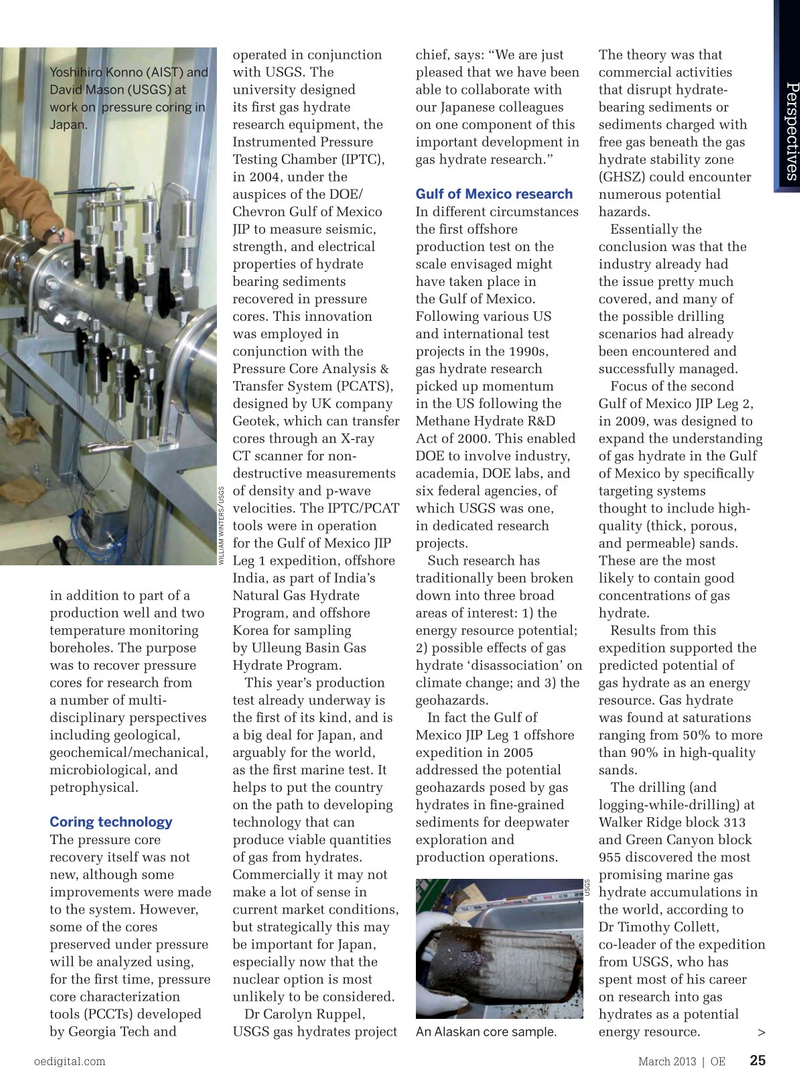
Page 23: of Offshore Engineer Magazine (Mar/Apr 2013)
Read this page in Pdf, Flash or Html5 edition of Mar/Apr 2013 Offshore Engineer Magazine
operated in conjunction chief, says: “We are just The theory was that with USGS. The pleased that we have been commercial activities
Yoshihiro Konno (AIST) and
Perspectives university designed able to collaborate with that disrupt hydrate-
David Mason (USGS) at its frst gas hydrate our Japanese colleagues bearing sediments or work on pressure coring in research equipment, the on one component of this sediments charged with
Japan.
Instrumented Pressure important development in free gas beneath the gas
Testing Chamber (IPTC), gas hydrate research.” hydrate stability zone in 2004, under the (GHSZ) could encounter auspices of the DOE/ Gulf of Mexico research numerous potential
Chevron Gulf of Mexico In different circumstances hazards.
JIP to measure seismic, the frst offshore Essentially the strength, and electrical production test on the conclusion was that the properties of hydrate scale envisaged might industry already had bearing sediments have taken place in the issue pretty much recovered in pressure the Gulf of Mexico. covered, and many of cores. This innovation Following various US the possible drilling was employed in and international test scenarios had already conjunction with the projects in the 1990s, been encountered and
Pressure Core Analysis & gas hydrate research successfully managed.
Transfer System (PCATS), picked up momentum Focus of the second designed by UK company in the US following the Gulf of Mexico JIP Leg 2,
Geotek, which can transfer Methane Hydrate R&D in 2009, was designed to cores through an X-ray Act of 2000. This enabled expand the understanding
CT scanner for non- DOE to involve industry, of gas hydrate in the Gulf destructive measurements academia, DOE labs, and of Mexico by specifcally of density and p-wave six federal agencies, of targeting systems velocities. The IPTC/PCAT which USGS was one, thought to include high- tools were in operation in dedicated research quality (thick, porous, / for the Gulf of Mexico JIP projects. and permeable) sands.
Leg 1 expedition, offshore Such research has These are the most williamwinters usgs
India, as part of India’s traditionally been broken likely to contain good in addition to part of a Natural Gas Hydrate down into three broad concentrations of gas production well and two Program, and offshore areas of interest: 1) the hydrate.
temperature monitoring Korea for sampling energy resource potential; Results from this boreholes. The purpose by Ulleung Basin Gas 2) possible effects of gas expedition supported the was to recover pressure Hydrate Program. hydrate ‘disassociation’ on predicted potential of cores for research from This year’s production climate change; and 3) the gas hydrate as an energy a number of multi- test already underway is geohazards. resource. Gas hydrate disciplinary perspectives the frst of its kind, and is In fact the Gulf of was found at saturations including geological, a big deal for Japan, and Mexico JIP Leg 1 offshore ranging from 50% to more geochemical/mechanical, arguably for the world, expedition in 2005 than 90% in high-quality microbiological, and as the frst marine test. It addressed the potential sands. petrophysical. helps to put the country geohazards posed by gas The drilling (and on the path to developing hydrates in fne-grained logging-while-drilling) at
Coring technology technology that can sediments for deepwater Walker Ridge block 313
The pressure core produce viable quantities exploration and and Green Canyon block recovery itself was not of gas from hydrates. production operations. 955 discovered the most new, although some Commercially it may not promising marine gas usgs improvements were made make a lot of sense in hydrate accumulations in to the system. However, current market conditions, the world, according to some of the cores but strategically this may Dr Timothy Collett, preserved under pressure be important for Japan, co-leader of the expedition will be analyzed using, especially now that the from USGS, who has for the frst time, pressure nuclear option is most spent most of his career core characterization unlikely to be considered. on research into gas tools (PCCTs) developed Dr Carolyn Ruppel, hydrates as a potential by Georgia Tech and USGS gas hydrates project energy resource. >
An Alaskan core sample.
oedigital.com March 2013 | OE 25 oe_analysis_rev3.indd 25 27/02/2013 11:23

 22
22

 24
24